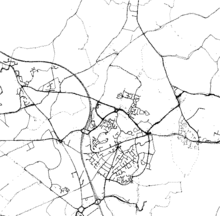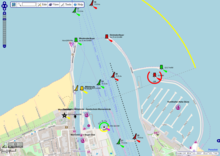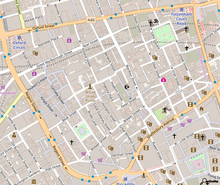OpenStreetMap: Difference between revisions
m Source for wikipedia comparison |
+url to WMS server list |
||
| Line 97: | Line 97: | ||
|- |
|- |
||
| [http://www.informationfreeway.org Information Freeway] || general, almost realtime || Worldwide |
| [http://www.informationfreeway.org Information Freeway] || general, almost realtime || Worldwide |
||
|- |
|||
| [http://wiki.openstreetmap.org/wiki/WMS OSM WMS Servers] || general, Web Map Services || Worldwide |
|||
|- |
|- |
||
| [http://openseamap.org/ OpenSeaMap] || nautical map || seas, oceans and waterways |
| [http://openseamap.org/ OpenSeaMap] || nautical map || seas, oceans and waterways |
||
Revision as of 17:14, 19 July 2009
 | |
 OpenStreetMap of Cambridge | |
Type of site | Collaborative mapping |
|---|---|
| Owner | OpenStreetMap Foundation |
| Created by | Steve Coast |
| URL | http://www.openstreetmap.org |
| Commercial | No |
| Registration | required for contributors |
OpenStreetMap (OSM) is a collaborative project to create a free editable map of the world.
The maps are created using data from portable GPS devices, aerial photography, other free sources or simply from local knowledge. Both rendered images and the vector dataset are available for download under a Creative Commons Attribution-ShareAlike 2.0 licence.[1]
OpenStreetMap was inspired[2] by sites such as Wikipedia — the map display features a prominent 'Edit' tab and a full revision history is maintained. Registered users can upload GPS track logs and edit the vector data using the given editing tools.
History

OpenStreetMap (OSM) was founded in July 2004 by Steve Coast. In April 2006, a foundation was established with the aim of encouraging the growth, development and distribution of free geospatial data and providing geospatial data for anybody to use and share. In December 2006 Yahoo confirmed that OpenStreetMap could use their aerial photography as a backdrop for map production.[3]
In April 2007 Automotive Navigation Data donated a complete road dataset for the Netherlands and trunk road data for India and China to the project[4] and by July 2007, when the first OSM international The State of the Map conference was held there were 9,000 registered users. Sponsors of the event included Google, Yahoo and Multimap. In August 2007 an independent project, OpenAerialMap, was launched, to hold a database of aerial photography available on open licensing[5] and in October 2007 OpenStreetMap completed the import of a US Census TIGER road dataset.[6] In December Oxford University became the first major organisation to use OpenStreetMap data on their main website.[7]
In January 2008 functionality was made available to download map data into a GPS unit for use by cyclists.[8] In February 2008 a series of workshops were held in India.[9] In March two founders announced that they have received venture capital funding of 2.4m euros for Cloud Made, a commercial company that will use OpenStreetMap data.[10]
By August 2008, shortly after the second The State of the Map conference was held, there were over 50,000 registered users with over 5,000 active contributors.[11] In March 2009, 100,000 users were surpassed.[12]
Map production

Technique
The initial map data was all built from scratch by volunteers performing systematic ground surveys using a handheld GPS unit and a notebook or a voice recorder, data which was then entered into the OpenStreetMap database from a computer.
More recently the availability of aerial photography and other data sources from commercial and government sources has greatly increased the speed of this work and has allowed land-use data to be collected more accurately.
When large datasets are available a technical team will manage the conversion and import of the data.
Structured ground surveys

Ground surveys are performed by a volunteer, on foot, bicycle or in a car. Map data is usually collected using a GPS unit, although this isn't strictly necessary if an area has already been traced from satellite imagery.
Once the data has been collected, it's entered into the database using one of several purpose-built map editors. Some committed contributors are systematically mapping whole towns and cities over a period of time, or organising mapping parties to intensively map a particular area over an evening or a weekend.
In addition to structured surveys, a large number of smaller edits are made by contributors to correct errors or add features.
Government data sources
Some government agencies have released official data on appropriate licenses. Much of this data has come from the United States, where the federal government cannot copyright such data.
- Landsat 7 satellite imagery
- Prototype Global Shorelines (PGS)
- TIGER data of the United States
Various authorities have also made more local detailed aerial photography available on suitable licenses through OpenAerialMap.
The UK Ordnance Survey is legally a Trading Fund and as such is required to earn money from selling its data and is not open to contributing data to the project.[13] Consideration is however currently being given to changing the structure of the organization to make its data more available.[14] In 2006 The Guardian launched a campaign named 'Free our data' to support freeing up government data including mapping data[15]. The Government's Shareholder Executive will report on its latest review of the Trading Funds in the 2008 Pre-Budget Report, due in the autumn[vague].
Out-of-copyright maps can be good source of information about features which don't change frequently. Copyright periods vary, but in the UK 'Crown copyright' expires after 50 years and hence Ordnance Survey maps until the 1950s can legally be used. A complete set of UK 1 inch/mile maps from the late 1940s and early 1950s have been collected, scanned and are available online as a resource for contributors.
Commercial data sources
Some commercial companies have donated data to the project on suitable licenses. Notably, Automotive Navigation Data (AND) who provided a complete road dataset for Netherlands and details of trunk roads in China and India.
In December 2006, Yahoo! confirmed that OpenStreetMap was able to make use of their vertical aerial imagery and this photography is now available within the editing software as an overlay. Contributors can create their vector based maps as a derived work, released with a free and open license.[16]
Licensing

The OpenStreetMap database
OpenStreetMap data is published under an open content license, with the intention of promoting free use and re-distribution of the data (both commercial and non-commercial). The license used is currently the Creative Commons Attribution-Share Alike 2.0 licence, however legal investigation work and community consultation is under-way to re-license the project under the Open Database License (ODbL) from Open Data Commons (ODC) which is more suitable for a map dataset.[1]
Input data
All data added to the project needs to have a license compatible with the Creative Commons Attribution-Share Alike license. This can include out of copyright information, public domain or other licenses. All contributors must register with the project and agree to provide data on a Creative Commons BY-SA 2.0 licence or determine that the licencing of the source data is suitable. Increasingly this involves examining licences for government data to establish if it they are compatible. Use of unfree data is an especially severe problem for a map, as the only way to prove that no data came from unfree sources would be to revert the whole area in question to before the addition of the questionable data.
A subset of contributors have made their contributions available as public domain.[17]
Software
Software used in the production and presentation of OpenStreetMap data is available from many different projects and each may have their own licencing. The core software to manage the databases, user interaction and the API are available under a GNU General Public License.[18]
Usage
OpenStreetMap data is available through an increasing number of sites and in different formats:
On-line raster maps

Mapping is available online both on general mapping sites:
| Map | Theme | Area |
|---|---|---|
| OpenStreetMap | general, cyclists, debugging | Worldwide |
| Information Freeway | general, almost realtime | Worldwide |
| OSM WMS Servers | general, Web Map Services | Worldwide |
| OpenSeaMap | nautical map | seas, oceans and waterways |
| OpenStreetBrowser | features highlighting | Europe |
| FreeMap | walkers | parts of the UK |
| Topo | walkers and riders | Austria, Germany, Switzerland |
| OpenCycleMap | cyclists | Worldwide |
| Yournavigation | routing | Worldwide |
| OpenRouteService | routing | Europe |
| OpenPisteMap | skiing | some European and USA resorts[19] |
| CloudMade | general, mobile and various other custom styles | Worldwide |
| OSM Mapper | Debugging maps by Ito World Ltd |
Off-line raster maps
Hand held GPS receivers
- Garmin: There are several programs available that can convert OpenStreetMap data into Garmin compatible maps [20]
Mobile phones
A wide variety of programs exist by now that use OpenStreetMap data to display maps on mobile phones[21], supporting a large number of different devices. Amongst supported devices are nearly all phones that can run java for mobiles, making OpenStreetMap available to the majority of current phones, as well as platforms like the iPhone[22], Windows Mobile[23] or Openmoko. The various programs distinguish them selves according to key features like if they use raster maps or vector maps, if they need an internet connection or can be used offline, if they support address search or advanced features like routing, thus catering for a large number of different needs for viewing maps. With the inclusion of OpenStreetMap support in several programming libraries for mobile phones[24][25] it is also possible to include osm maps in other location-based service.
Flickr
Yahoo has started using OpenStreetMap data within its Flickr service for various cities around the world, including Baghdad, Beijing, Kabul, Sydney and Tokyo.[26][27][28].
Blogs
The wordpress OpenStreetMap plugin inserts maps and adds geo meta tags to posts / pages of wordpress blogs
Map data
Map data is available for download in a variety of formats and for different geographical areas:
Software
Map rendering and presentation

- Online Ajax-style OpenLayers based slippy map interface. Displaying map tiles rendered by:
- Mapnik — C++ open source map rendering software used on the main OSM site
- Osmarender — XSLT style sheets for generating SVG images from OSM data. Used as part of the Tiles@home distributed map-rendering system for the main OSM site.
- Desktop
- Kosmos — Windows application for rendering maps, with an interactive mode and a local tile server mode
- OSMMap — Windows tool for browsing the OSM Maps (using Mapnik and Osmarender)
- tangoGPS — Open source, Linux-based mapping application for use with or without GPS. Suitable for use on many Linux platforms including desktops, the eeePC and phones such as the Openmoko Neo.
- Prune - Open source Java application for viewing and editing data recorded by GPS. Uses OSM for the map layers.
- GPSDrive - Open source car navigation application running on Linux/BSD/OS X
- Marble - Free and open source desktop-globe, which supports OpenStreetMap data.
- Phone and GPS displays
- Wordpress Blogs via OSM Plugin
Map data collection
- GPSBabel — converts tracklogs from one format to another.
- AFTrack — Symbian 60v3 for Nokia mobile phones, live tracking and routing software, from version 1.03 onwards
- WhereAmI - Symbian S60, S80, and UIQ live tracking and OSM data download and rendering (GPL'ed)
- MyMotion — Windows CE tracking software
- TrackMyJourney (TMJ) - J2ME tracking software, which show OSM data, and uses OSM data for routing over the air.
- OSM2Go — Mobile/Desktop Hildon/Gtk editor includes tracking functionality
- OSM Live - displays who is editing the Open Street Map in realtime
Map data editing


- Potlatch — Online Flash editor
- JOSM — Desktop Java editor
- Merkaartor — Desktop Qt editor
- OSM2Go — Mobile/Desktop Hildon/Gtk editor
Routing
List of Online Routing on the OSM wiki [1] List of Offline Routing on the OSM wiki [2]
- Gosmore
- Navit
- Pyroute
- OpenRouteService
- Traveling salesman - Open source java application working as route-planner and GPS-Navigator using the map-data from OpenStreetMap via LibOSM
Data format
OpenStreetMap uses a topological data structure.
- Nodes are points with a geographic position.
- Ways are lists of nodes, representing a polyline or polygon.
- Relations are groups of nodes, ways and other relations which can be assigned certain properties.
- Tags can be applied to nodes, ways or relations and consist of name=value pairs.
Up to version 0.4 of its protocol, an intermediate element between nodes and ways (segments) was also used.
An optional ontology of map features (the meaning of tags) is maintained on a wiki.
See also
References
- ^ a b Richard Fairhurst (2008-01-07). "The licence: where we are, where we're going". OpenGeoData. Retrieved 2008-07-24.
- ^ Steve Coats in derStandard.at, 2009-07-13 (in German)
- ^ http://www.opengeodata.org/?p=120
- ^ http://www.opengeodata.org/?p=223
- ^ http://www.opengeodata.org/?p=230
- ^ http://www.linux.com/feature/119493?theme=print
- ^ http://geothought.blogspot.com/2007/12/oxford-university-using-openstreetmap.html
- ^ http://www.systemed.net/blog/entry080113140415.html
- ^ openstreetmap:India
- ^ http://blog.cloudmade.com/2008/03/17/were-funded/
- ^ http://www.opengeodata.org/?p=309
- ^ http://www.opengeodata.org/?p=444
- ^ Ordnance Survey - Trading on geographic intelligence
- ^ The Office of Fair Trading: OFT welcomes government review of public sector information
- ^ SA Mathieson and Michael Cross (2006-03-23). "Ordnance Survey challenged to open up". The Guardian. Retrieved 2009-02-23.
{{cite news}}: Check date values in:|date=(help) - ^ Steve Coast (2006-12-04). "Yahoo! aerial imagery in OSM". OpenGeoData. Retrieved 2008-07-23.
- ^ "OpenStreetMap Legal FAQ".
Several contributors additionally make their code available under different licences
- ^ "OpenStreetMap License".
OpenStreetMap software is licensed under the GNU GPL
- ^ openstreetmap:WikiProject Piste Maps
- ^ Openstreetmap:OSM Map On Garmin
- ^ openstreetmap:Software/Mobilephones
- ^ openstreetmap:IPhone
- ^ openstreetmap:WinPDA
- ^ "mgmapslib".
- ^ "Cloudmade mobile API".
- ^ "Around the world and back again". blog-flickr.net. Retrieved 2008-11-07.
- ^ "More cities". blog-flickr.net. Retrieved 2008-11-07.
- ^ "Japanese progress in osm. Amazing stuff!".
- ^ http://planet.openstreetmap.org/
- ^ http://downloads.cloudmade.com/
- ^ http://download.geofabrik.de/osm/
External links
- www.openstreetmap.org - Project page
- OpenStreetMap Foundation
- Project Wiki
- OpenAerialMap
- geo.topf.org online-comparison between Google and OpenStreetMap
- OpenSource navigation system
